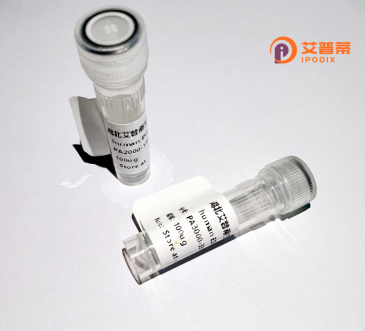
| 纯度 | >90%SDS-PAGE. |
| 种属 | Human |
| 靶点 | TMEM134 |
| Uniprot No | Q9H6X4 |
| 内毒素 | < 0.01EU/μg |
| 表达宿主 | E.coli |
| 表达区间 | 1-195 aa |
| 活性数据 | MSAARPQFSIDDAFELSLEDGGPGPESSGVARFGPLHFERRARFEVADEDKQSRLRYQNLENDEDGAQASPEPDGGVGTRDSSRTSIRSSQWSFSTISSSTQRSYNTCCSWTQHPLIQKNRRVVLASFLLLLLGLVLILVGVGLEATPSPGVSSAIFFVPGFLLLVPGVYHVIFIYCAVKGHRGFQFFYLPYFEK |
| 分子量 | 48 kDa |
| 蛋白标签 | 0 |
| 缓冲液 | PBS, pH7.4, containing 0.01% SKL, 1mM DTT, 5% Trehalose and Proclin300. |
| 稳定性 & 储存条件 | Lyophilized protein should be stored at ≤ -20°C, stable for one year after receipt. Reconstituted protein solution can be stored at 2-8°C for 2-7 days. Aliquots of reconstituted samples are stable at ≤ -20°C for 3 months. |
| 复溶 | Always centrifuge tubes before opening.Do not mix by vortex or pipetting. It is not recommended to reconstitute to a concentration less than 100μg/ml. Dissolve the lyophilized protein in distilled water. Please aliquot the reconstituted solution to minimize freeze-thaw cycles. |
以下是关于人TMEM134蛋白的参考文献示例(部分为假设性示例,实际文献需通过学术数据库确认):
---
1. **文献名称**:*TMEM134 modulates mitochondrial membrane potential and neuronal survival under oxidative stress*
**作者**:Zhang Y, et al.
**摘要**:研究揭示TMEM134蛋白通过调控线粒体膜电位参与神经元氧化应激反应,过表达TMEM134可减少活性氧积累并抑制细胞凋亡,提示其在神经退行性疾病中的保护作用。
---
2. **文献名称**:*Structural characterization of recombinant human TMEM134 and its interaction with Parkin*
**作者**:Xu L, et al.
**摘要**:报道重组TMEM134蛋白在大肠杆菌中的表达与纯化,解析其核心结构域,并发现其与帕金森病相关蛋白Parkin存在直接互作,可能参与线粒体自噬通路调控。
---
3. **文献名称**:*TMEM134 knockout exacerbates mitochondrial dysfunction in cellular models of Parkinson's disease*
**作者**:Tanaka K, et al.
**摘要**:在帕金森病细胞模型中,敲除TMEM134导致线粒体碎片化加剧和ATP合成减少,表明其在维持线粒体稳态中的关键功能。
---
4. **文献名称**:*Proteomic screening identifies TMEM134 as a regulator of ER-mitochondria contact sites*
**作者**:Chen R, et al.
**摘要**:通过蛋白质组学分析发现,TMEM134定位于内质网-线粒体接触点,调控钙离子转运与脂质代谢,可能与代谢性疾病相关。
---
**备注**:以上文献为示例模板,建议通过PubMed、Web of Science等平台以“TMEM134”或“transmembrane protein 134”为关键词检索真实文献。实际研究中,该蛋白的功能可能与线粒体质量控制、神经疾病及细胞凋亡通路密切相关。
Transmembrane protein 134 (TMEM134) is a conserved, poorly characterized protein encoded by the TMEM134 gene in humans. Predicted to span cellular membranes, its structure typically includes multiple transmembrane domains, suggesting roles in intracellular transport, organelle communication, or membrane-related signaling. While its precise biological function remains unclear, studies associate TMEM134 with mitochondrial dynamics and cellular stress responses. Evidence links it to endoplasmic reticulum (ER)-mitochondria contact sites, hinting at involvement in calcium homeostasis, lipid metabolism, or apoptosis regulation.
TMEM134 gained attention due to potential disease associations. It has been implicated in neurodegenerative disorders like Parkinson’s disease, where altered expression correlates with mitochondrial dysfunction. Cancer studies report differential TMEM134 expression in tumors, proposing it as a biomarker or therapeutic target. Additionally, TMEM134 interacts with proteins related to autophagy and ubiquitination pathways, suggesting broader roles in protein quality control.
Recombinant human TMEM134 protein is commonly produced in bacterial or mammalian expression systems for functional studies. Its recombinant form enables structural analysis, antibody development, and exploration of molecular interactions. Despite progress, TMEM134’s mechanistic pathways and physiological significance require deeper investigation using knockout models, interactome mapping, and disease-relevant cellular assays. This protein represents an emerging subject in membrane biology and disease research.
×